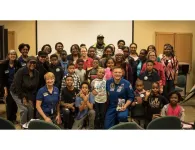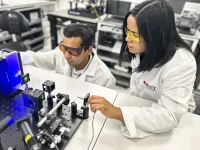(Press-News.org) When we walk around in our everyday life, we might not think of the Earth itself very often. But this planet is the foundation of our life. The air we breathe, the water we drink and the gravity that pins us to the ground.
Up until now, researchers believed that it took more than 100 million years for the Earth to form. And it was also common belief that water was delivered by lucky collisions with water-rich asteroids like comets.
However, a new study from the University of Copenhagen suggests that it might not have happened entirely by chance.
“We show that the Earth formed by the very fast accumulation of small millimeter-sized pebbles. In this mechanism, the Earth was formed in just a few million years. Based on our findings, it appears that the presence of water on Earth is a byproduct of its formation” says Martin Bizzarro, who is a Professor at Globe Institute and one of the researchers behind the new study.
The results of the research not only show that the Earth was created much faster than previously thought, but that the presence of water is a predicted outcome of its formation process. This is important knowledge because it tells us something about planets outside our own Solar System.
“With this new planet formation mechanism, the chance of having habitable planets in the galaxy is much higher than we previously thought,” says Martin Bizzarro.
A greater chance of water on other planets
Habitability is the potential for a planet to have the right ingredients at its surface for life to develop. One key ingredient for habitability is water.
“People have debated how planets form for a long time. One theory is that planets are formed by the gradual collision of bodies, progressively increasing their size over 100 million years. In this scenario, the presence of water on Earth would need a sort of chance event,” says Associate Professor Martin Schiller who is also behind the new study.
An example of this could be if comets, which are icy bodies, bombarded the surface of Earth towards the end of its formation.
“If that is how Earth was formed, then it is pretty lucky that we have water on Earth. This makes the chances that there is water on planets outside our Solar System very low,” says Martin Schiller.
Instead, the researchers behind the new study suggests a new theory of how Earth was created.
“There was a disk around the young Sun where the planets were growing. The disk was filled with small dust particles. Once a planet reaches a certain size, it sorts of act like a vacuum cleaner, sucking up all that dust very quickly. And that makes it grow to the size of Earth in just a few million years,” says Ph.D. student Isaac Onyett, who is the corresponding author of the study.
This vacuuming of small dust particles not only played a vital role in Earth’s formation but made sure that water was delivered to our planet.
"The disk also contains many icy particles. As the vacuum cleaner effect draws in the dust, it also captures a portion of the ice. This process contributes to the presence of water during Earth’s formation, rather than relying on a chance event delivering water 100 million years later,” says Isaac Onyett.
With the new knowledge and understanding of the mechanisms there is a much greater chance of water being present on other planets.
“This theory would predict that whenever you form a planet like Earth, you will have water on it. If you go to another planetary system where there is a planet orbiting a star the size of the Sun, then the planet should have water if it is in the right distance,” says Martin Bizzarro.
How the researchers did
The researchers used silicon isotopes as a tool to understand the mechanisms and timescales of planet formation. By analyzing the isotopic composition of more than 60 different meteorites and planetary bodies, the researchers were able to establish genetic relationships between rocky planets like Earth and Mars and other celestial objects. This approach allowed the researchers to of the type of building blocks that assembled to form Earth, and the process by which they came together.
END
Earth was created much faster than we thought. This makes the chance of finding other habitable planets in the Universe more likely
2023-06-14
ELSE PRESS RELEASES FROM THIS DATE:
A scorching-hot exoplanet scrutinized by UdeM astronomers
2023-06-14
An international team led by Stefan Pelletier, a Ph.D. student at Université de Montréal's Trottier Institute for Research on Exoplanets announced today having made a detailed study of the extremely hot giant exoplanet WASP-76 b.
Using the MAROON-X instrument on the Gemini-North Telescope, the team was able to identify and measure the abundance of 11 chemical elements in the atmosphere of the planet.
Those include rock-forming elements whose abundances are not even known for giant planets in the Solar System such as Jupiter or Saturn. The team's study is published in ...
A growing number of producers and industries interested in precision livestock farming
2023-06-14
Some of the world’s best minds that are focused on profitable and sustainable livestock production attended and presented at the recent Second U.S. Precision Livestock Farming Conference. Hosted by University of Tennessee AgResearch, the May 21-24 event at the UT Conference Center in Knoxville attracted 219 attendees representing 22 countries and 32 U.S. states. Participants included academics, representatives of government agencies and allied industries as well as producers. The conference had a central theme of “Field Application of PLF Technologies” and academic presentations along with two industry and producer panels included interactive dialogues among the attendees ...
It takes a village: Study shows community is key to a sustained passion for science among adolescents
2023-06-14
The results of a yearlong science program show that one of the best ways to instill a lasting interest in science among children is to engage them alongside their family members. This finding runs counter to the current framework, in which children attend science-related summer camps and after-school programs apart from their families, diminishing the long-term potential of what they learn.
“We wanted to see if we could support families as a whole, as opposed to giving a student a really amazing one-off experience and sending them ...
Racial disparities found in one of first studies of pharmacological treatment of insomnia
2023-06-14
INDIANAPOLIS — In one of the first studies to investigate racial disparities in the pharmacologic treatment of insomnia, researchers from Regenstrief Institute and Indiana University report that patients belonging to racial minority groups were significantly less likely to be prescribed medication following diagnosis of insomnia than White patients.
The study found that Black patients were much less likely to have been prescribed an FDA-approved insomnia medication at any time post diagnosis than White patients. Other non-White individuals were significantly less likely to be prescribed an FDA-approved medication two, three, and four years after insomnia diagnosis ...
New York Academy of Sciences, Leon Levy Foundation name first 10 Leon Levy Scholars in Neuroscience
2023-06-14
New York, NY, June 14, 2023 — The New York Academy of Sciences and the Leon Levy Foundation announced today the first cohort of Leon Levy Scholars in Neuroscience; a continuation of an earlier fellowship program started by the Foundation in 2009 that has supported 160 fellows in neuroscience.
This highly regarded postdoctoral program supports exceptional young researchers across the five boroughs of New York City as they pursue innovative investigations in neuroscience and advance in their careers toward becoming independent principal investigators. Designed to broaden the field and to support researchers who might otherwise not ...
Cancer researchers focused on bringing new discoveries to patients get two-year funding awards
2023-06-14
June 14, 2023, TORONTO — Funding announced today by the Ontario Institute for Cancer Research (OICR) will help six Ontario-based research teams pursue their ultimate goal of improving the lives of people with cancer.
Funding comes through OICR’s Innovation to Implementation (I2I) program, which aims to help ensure new discoveries about preventing, diagnosing and treating cancer are adopted into healthcare policy and clinical practice.
“Every cancer researcher wants their work to have ...
Dr. Jonathan Weinsaft named chief of the Greenberg Division of Cardiology at Weill Cornell Medicine and NewYork-Presbyterian/Weill Cornell Medical Center
2023-06-14
NEW YORK (June 14, 2023)— Dr. Jonathan Weinsaft, an esteemed physician-scientist who focuses on clinical research and cardiovascular imaging, has been appointed chief of the Greenberg Division of Cardiology at Weill Cornell Medicine and NewYork-Presbyterian/Weill Cornell Medical Center, effective July 1.
The Greenberg Division of Cardiology, housed within the Weill Department of Medicine, is dedicated to diagnosing and treating patients with disorders of the heart and blood vessels that comprise the cardiovascular system.
In his new role, Dr. Weinsaft will further strengthen the division as a leader in scientific and technological ...
New diagnostic finds intact sperm in infertile men
2023-06-14
In a recent study, researchers created a diagnostic test to identify functional sperm in infertile men that could change the treatment of male infertility and assisted reproductive technology.
“Male infertility is a recognized issue and deserves scientific and clinical attention,” said Andrei Drabovich, an assistant professor of laboratory medicine and pathology at the University of Alberta and corresponding author of the Molecular & Cellular Proteomics study.
One in every six couples trying to conceive experience infertility issues. In fact, about 10% of men in the United States are infertile. The most ...
A novel technique to observe colloidal particle degradation in real time
2023-06-14
In the early 2000s, scientists from the UK made a worrisome discovery that the oceans are teeming with small particles of plastic (less than one millimeter in length) due to the continuous degradation of plastic waste. These microscopic particles of plastic have become a major environmental concern. Scientists classify these small particles as either microplastics or nanoplastics based on their size; the latter term is used exclusively for particles smaller than one micrometer.
These particles easily get embedded into the bodies of marine and freshwater animals, ...
Tiny device mimics human vision and memory abilities
2023-06-14
Researchers have created a small device that ‘sees’ and creates memories in a similar way to humans, in a promising step towards one day having applications that can make rapid, complex decisions such as in self-driving cars.
The neuromorphic invention is a single chip enabled by a sensing element, doped indium oxide, that’s thousands of times thinner than a human hair and requires no external parts to operate.
RMIT University engineers in Australia led the work, with contributions from researchers at Deakin University and the University of Melbourne.
The team’s research demonstrates a working device that captures, processes and stores visual ...






